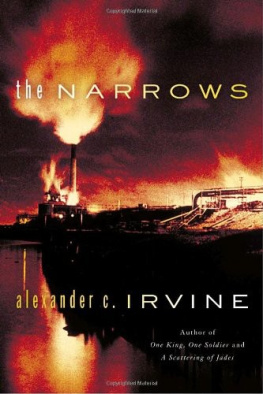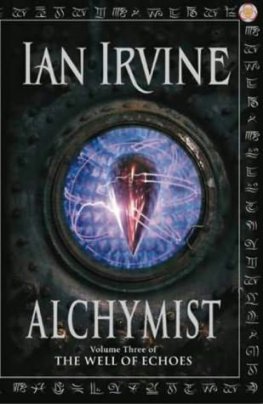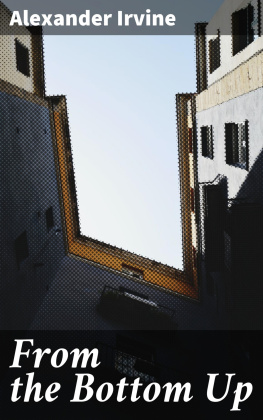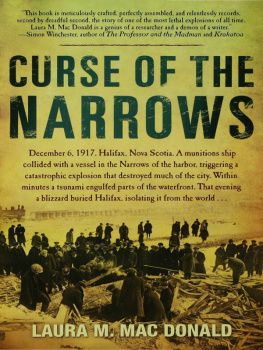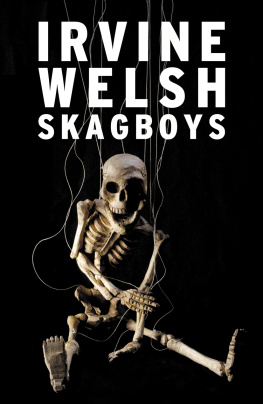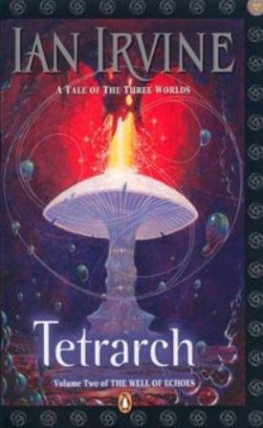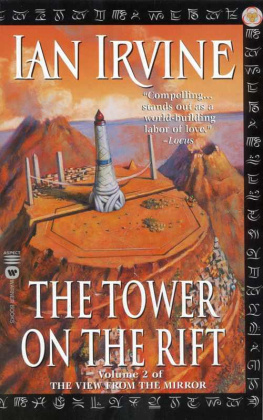Alexander C. Irvine - The Narrows
Here you can read online Alexander C. Irvine - The Narrows full text of the book (entire story) in english for free. Download pdf and epub, get meaning, cover and reviews about this ebook. year: 2005, publisher: Del Rey, genre: Detective and thriller. Description of the work, (preface) as well as reviews are available. Best literature library LitArk.com created for fans of good reading and offers a wide selection of genres:
Romance novel
Science fiction
Adventure
Detective
Science
History
Home and family
Prose
Art
Politics
Computer
Non-fiction
Religion
Business
Children
Humor
Choose a favorite category and find really read worthwhile books. Enjoy immersion in the world of imagination, feel the emotions of the characters or learn something new for yourself, make an fascinating discovery.
- Book:The Narrows
- Author:
- Publisher:Del Rey
- Genre:
- Year:2005
- Rating:4 / 5
- Favourites:Add to favourites
- Your mark:
- 80
- 1
- 2
- 3
- 4
- 5
The Narrows: summary, description and annotation
We offer to read an annotation, description, summary or preface (depends on what the author of the book "The Narrows" wrote himself). If you haven't found the necessary information about the book — write in the comments, we will try to find it.
The Narrows — read online for free the complete book (whole text) full work
Below is the text of the book, divided by pages. System saving the place of the last page read, allows you to conveniently read the book "The Narrows" online for free, without having to search again every time where you left off. Put a bookmark, and you can go to the page where you finished reading at any time.
Font size:
Interval:
Bookmark:
THE NARROWS
Alexander C. Irvine
BALLANTINE BOOKS - NEW YORK
The Narrows is a work of fiction. Names, characters, places, and incidents are the products of the author's imagination or are used fictitiously. Any resemblance to actual events, locales, or persons, living or dead, is entirely coincidental.
A Del Rey Trade Paperback Original
Copyright 2005 by Alexander Irvine
All rights reserved.
Published in the United States by Del Rey Books, an imprint of The Random House Publishing Group, a division of Random House, Inc., New York.
DEL REY is a registered trademark and the Del Rey colophon is a trademark of Random House, Inc.
Library of Congress Cataloging-in-Publication Data
Irvine, Alexander (Alexander C.)
The narrows Alexander C. Irvine.p>
p. cm.
A Del Rey trade paperback original'T.p. verso.
eISBN 0-345-48611-0
1. World War, 1939-1945 Michigan Detroit Fiction. 2. Detroit (Mich.) Fiction. 3. Factories Fiction. 4. Rabbis Fiction. 5. Golem Fiction. I. Title.
PS3609.R85N37 2005
813.6 dc22
2005041338
www.delreybooks.com
v1.0
Midnight in the golem factory. Sweat and clay and blisters. Twitching pains in the wrist and the small of the back. The door to Moises' sanctum opens and closes. The motion of Moises' passing bangs the row of hanging platforms together, as if the unlivened molds were thrashing in whatever nightmares afflict clay that knows it must be born.
Twenty-three men work in what is now called Building G, a steel-and-glass afterthought of Albert Kahn's near the center of the Ford River Rouge factory complex, the rusting, monstrous alimentary canal of Henry Ford's empire, taking in raw materials and excreting Model A Fords by the thousand every day. Ford has refused all government contracts to build war matriel for the British, but someone somewhere agreed that Building G could be spared for an odd little project away from the Old Man's increasingly confused oversight. Nobody knows how this happened, and they don't much care as long as it works, which will be determined in about an hour. They think.
Inside Building G, the three-story space is ringed by a catwalk twelve feet above the floor. Two doors off the catwalk lead to overpasses that in turn connect to other buildings. One of the doors, on the north wall, is usually under tight surveillance by Building G's crew because that's where Swerdlow comes from, and it's a poor bunch of line rats that doesn't know where their supervisor is at all times. On the ground floor three large bay doors face the train siding outside, and beyond it the canal slip that leads down to the turning basin and the Rouge River. Spanning the ceiling, a spine of girders supports a crane-mounted scoop bucket. Clay comes in on trains, three or four open cars at a time backing down a spur off the Detroit, Toledo & Ironton Railroad. When the locomotive detaches, someone has to go find a union guy to operate the scoop bucket; the UAW fought hard to take the Rouge, and with their victory so recent they're hardasses about niggling little details. Usually this entails a trip down to the canal slip, where the crane operators gather to play cards and pass a bottle, and the union crane guys don't at all like having to demean their profession by operating Building G's little bucket. They draw straws to see who will miss out on the rest of the liquor. Once the unlucky operator is dragooned and herded back to Building G, the scoop bucket drops giant clots of streaming, weedy goo onto a screen just inside Building G; the screener comes to life, shaking the bucketloads into pieces small enough to fall through the screen onto a conveyor belt. A work detail of a dozen men goes at this steady flow of head-sized gobs of clay with pick and shovel, breaking it down and pitching it onto the sorting line still squirming with swamp life. The breakdown and sorting crews are under strict orders to kill as few of these worms and snails and crawdads as they can manage, on Moises' eccentric theory that the incorporation of these little lives will make the golems that much stronger and more unpredictable in battle. Nobody knows if this strategy will pay off, since the Golem Line has just gone into production today, but every man on the line has thought at least once that at the end of eight hours of shoveling clay, it's hard to worry about the lives of snails.
It would be a hell of a lot more efficient to use the same clay pits that provided most of the Rouge's bricks; after all, some of them are still on the property. But even defending the Republic, Henry Ford is a tight man with a dollar. Good brickmaking clay is too useful to divert to a crazy Yid project like making golems, and anyway he's got God's own bounty of the stuff coming out of the swampy parts of the various parcels of Southern Michigan that he's busy turning into an industrial paradise. All of this raw stuff comes with impurities in the form of roots, rocks, rusted bits of metal, and enough cigarette butts to make the Army Air Corps' monthly rationnot to mention frogs, snakes, and occasionally fish, once in a while an unlucky muskrat. If this were a regular industrial operation, all of this stuff would be screened and pressed out of the clay, but Moises isn't rational on the topic, so anything that once had a pulse is supposed to be left on the sorting belt. At the same time the old rabbi is mortally convinced that only detailed human attention will get rid of all bits of metal. 'You don't want to see what happens if I raise a golem that has a bent nail still in it,' he says. The men on the linethat minority among them, in any case, who aren't refugees or immigrants from Eastern Europedon't know what to make of Moises. He's skeletal and hunched and speaks English like a bad caricature out of The Dearborn Independent or one of Father Coughlin's nightmares, and since this is their first day of operation they haven't actually seen him come up with a golem. If he says that something bad would happen if they left a nail in the clay, though, they're all willing to go along with it.
The sorting crew, half a dozen men, works with trowels and rakes to break the clay down into clots that would fit nicely in your hand. At the end of the conveyor, these clots pass under a magnet with some kind of gadget attached that lights up if they've missed a piece of steel. If the gadget lights up, the belt stops until the sorters find what set it off. Under that part of the belt is a bin full of nails, train sprockets, broken watches, all kinds of stuff. At the end of every shift, they're supposed to roll the bin to the scrapyard behind the blast furnaces.
Every so often, more often than they would have figured given what the clay has been through to get to this point, a live frog springs out of the piles. If Swerdlow isn't in the neighborhood, they stop the line and chase around after it. Whoever catches the frog decides what to do with it; the line is about evenly divided among three opinions. Some hold that the frog should be immobilized in the clay for molding into a golem; others that any frog with the gumption to live through excavation, transport, shoveling, picking, and sorting deserves a get-out-of-jail-free card by way of the canal; still others that the primary function of live frogs is to become frog legs.
Snakes are by common consent preserved to be put into Swerdlow's desk. This is a tradition that predates the golem project, predates even the war. Before the Rouge went union, back in 1938 or so when Swerdlow was one of Harry Bennett's Special Service goons, he had once made a Pole by the name of Czerkawski eat a dead snake right at his station, and then fired him for holding up the line. Then, the old-timers like to say, putting a snake in Swerdlow's desk was like being blooded in combat. There were consequences. Now all he does is charge out of his office and scream at whoever is walking by, but even this small reward is enough to keep the practice alive.
Next pageFont size:
Interval:
Bookmark:
Similar books «The Narrows»
Look at similar books to The Narrows. We have selected literature similar in name and meaning in the hope of providing readers with more options to find new, interesting, not yet read works.
Discussion, reviews of the book The Narrows and just readers' own opinions. Leave your comments, write what you think about the work, its meaning or the main characters. Specify what exactly you liked and what you didn't like, and why you think so.

